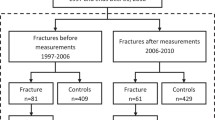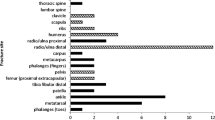Abstract
Summary
About 75% of patients suffering from osteoporosis are not diagnosed. This study describes a multi-site bone ultrasound method for osteoporosis diagnostics. In comparison with axial dual energy X-ray absorptiometry (DXA), the ultrasound method showed good diagnostic performance and could discriminate fracture subjects among elderly females.
Introduction
Axial DXA, the gold standard diagnostic method for osteoporosis, predicts fractures only moderately. At present, no reliable diagnostic methods are available at the primary health care level. Here, a multi-site ultrasound method is proposed for osteoporosis diagnostics.
Methods
Thirty elderly women were examined using the ultrasound backscatter measurements in proximal femur, proximal radius, proximal and distal tibia in vivo. First, we predicted the areal bone mineral density (BMD) at femoral neck by ultrasound measurements in tibia combined with specific subject characteristics (density index, DI) and, second, we tested the ability of ultrasound backscatter measurements at proximal femur to discriminate between individuals with previously fractured hips from those without fractures. Areal BMD was determined by axial DXA.
Results
Combined ultrasound parameters, cortical thickness at distal and proximal tibia, with age and weight of the subject, provided a significant estimate of BMDneck (r = 0.86, p < 0.001, n = 30). When inserted into FRAX (World Health Organization fracture risk assessment tool), the DI indicated the same treatment proposal as the BMDneck with 86% sensitivity and 100% specificity. The receiver operating characteristic analyses, with a combination of ultrasound parameters and patient characteristics, discriminated fracture subjects from the controls similarly as the model combining BMDneck and patient characteristics.
Conclusions
For the first time, ultrasound backscatter measurements of proximal femur were conducted in vivo. The results indicate that ultrasound parameters, combined with patient characteristics, may provide a means for osteoporosis diagnostics.



Similar content being viewed by others
References
Aula AS, Toyras J, Hakulinen MA, Jurvelin JS (2009) Effect of bone marrow on acoustic properties of trabecular bone–3D finite difference modeling study. Ultrasound Med Biol 35:308–318
Barkmann R, Dencks S, Laugier P, Padilla F, Brixen K, Ryg J, Seekamp A, Mahlke L, Bremer A, Heller M, Gluer CC (2009) Femur ultrasound (FemUS)-first clinical results on hip fracture discrimination and estimation of femoral BMD. Osteoporos Int 21:969–976
Barkmann R, Laugier P, Moser U, Dencks S, Klausner M, Padilla F, Haiat G, Heller M, Gluer CC (2008) In vivo measurements of ultrasound transmission through the human proximal femur. Ultrasound Med Biol 34:1186–1190
Blake GM, Chinn DJ, Steel SA, Patel R, Panayiotou E, Thorpe J, Fordham JN (2005) A list of device-specific thresholds for the clinical interpretation of peripheral X-ray absorptiometry examinations. Osteoporos Int 16:2149–2156
Bolotin HH (2007) DXA in vivo BMD methodology: an erroneous and misleading research and clinical gauge of bone mineral status, bone fragility, and bone remodelling. Bone 41:138–154
Bolotin HH, Sievanen H (2001) Inaccuracies inherent in dual-energy X-ray absorptiometry in vivo bone mineral density can seriously mislead diagnostic/prognostic interpretations of patient-specific bone fragility. J Bone Miner Res 16:799–805
Bousson V, Le Bras A, Roqueplan F, Kang Y, Mitton D, Kolta S, Bergot C, Skalli W, Vicaut E, Kalender W, Engelke K, Laredo JD (2006) Volumetric quantitative computed tomography of the proximal femur: relationships linking geometric and densitometric variables to bone strength. Role for compact bone. Osteoporos Int 17:855–864
Bouxsein ML, Palermo L, Yeung C, Black DM (2002) Digital X-ray radiogrammetry predicts hip, wrist and vertebral fracture risk in elderly women: a prospective analysis from the study of osteoporotic fractures. Osteoporos Int 13:358–365
Cherin E, Saied A, Laugier P, Netter P, Berger G (1998) Evaluation of acoustical parameter sensitivity to age-related and osteoarthritic changes in articular cartilage using 50-MHz ultrasound. Ultrasound Med Biol 24:341–354
Clowes JA, Peel NF, Eastell R (2006) Device-specific thresholds to diagnose osteoporosis at the proximal femur: an approach to interpreting peripheral bone measurements in clinical practice. Osteoporos Int 17:1293–1302
Gluer CC, Blake G, Lu Y, Blunt BA, Jergas M, Genant HK (1995) Accurate assessment of precision errors: how to measure the reproducibility of bone densitometry techniques. Osteoporos Int 5:262–270
Greenfield MA, Craven JD, Huddleston A, Kehrer ML, Wishko D, Stern R (1981) Measurement of the velocity of ultrasound in human cortical bone in vivo. Estimation of its potential value in the diagnosis of osteoporosis and metabolic bone disease. Radiology 138:701–710
Haiat G, Padilla F, Barkmann R, Dencks S, Moser U, Gluer CC, Laugier P (2005) Optimal prediction of bone mineral density with ultrasonic measurements in excised human femur. Calcif Tissue Int 77:186–192
Hakulinen MA, Day JS, Töyras J, Timonen M, Kröger H, Weinans H, Kiviranta I, Jurvelin JS (2005) Prediction of density and mechanical properties of human trabecular bone in vitro by using ultrasound transmission and backscattering measurements at 0.2–6.7 MHz frequency range. Phys Med Biol 50:1629–1642
Hoffmeister BK (2011) Frequency dependence of apparent ultrasonic backscatter from human cancellous bone. Phys Med Biol 56:667–683
Hoffmeister BK, Johnson DP, Janeski JA, Keedy DA, Steinert BW, Viano AM, Kaste SC (2008) Ultrasonic characterization of human cancellous bone in vitro using three different apparent backscatter parameters in the frequency range 0.6–15 MHz. IEEE Trans Ultrason Ferroelectrics Freq Contr 55:1442–1452
Hoffmeister BK, Jones CI 3rd, Caldwell GJ, Kaste SC (2006) Ultrasonic characterization of cancellous bone using apparent integrated backscatter. Phys Med Biol 51:2715–2727
Hoffmeister BK, Whitten SA, Rho JY (2000) Low-megahertz ultrasonic properties of bovine cancellous bone. Bone 26:635–642
Huopio J, Kröger H, Honkanen R, Jurvelin J, Saarikoski S, Alhava E (2004) Calcaneal ultrasound predicts early postmenopausal fractures as well as axial BMD. A prospective study of 422 women. Osteoporos Int 15:190–195
Johansen A, Evans W, Stone M (1999) Bone assessment in elderly women: what does a low bone ultrasound result tell us about bone mineral density? Arch Gerontol Geriatr 28:239–246
Kaleva E, Saarakkala S, Jurvelin JS, Viren T, Toyras J (2009) Effects of ultrasound beam angle and surface roughness on the quantitative ultrasound parameters of articular cartilage. Ultrasound Med Biol 35:1344–1351
Karjalainen J, Riekkinen O, Töyräs J, Kröger H, Jurvelin JS (2008) Ultrasonic assessment of cortical bone thickness in vitro and in vivo. IEEE Trans Ultrason Ferroelectrics Freq Contr 55:2191–2197
Karjalainen J, Töyras J, Rikkonen T, Jurvelin JS, Riekkinen O (2008) Dual-frequency ultrasound technique minimizes errors induced by soft tissue in ultrasound bone densitometry. Acta Radiol 49:1038–1041
Karjalainen JP, Toyras J, Riekkinen O, Hakulinen M, Jurvelin JS (2009) Ultrasound backscatter imaging provides frequency-dependent information on structure, composition and mechanical properties of human trabecular bone. Ultrasound Med Biol 35:1376–1384
Kilappa V, Moilanen P, Xu L, Nicholson PH, Timonen J, Cheng S (2011) Low-frequency axial ultrasound velocity correlates with bone mineral density and cortical thickness in the radius and tibia in pre- and postmenopausal women. Osteoporos Int 22:1103–1113
Malo M, Karjalainen JP, Riekkinen O, Isaksson H, Jurvelin JS, Töyras J (2011) Effects of non-optimal focusing of ultrasound on dual frequency ultrasound measurements of bone. (in press)
Marshall D, Johnell O, Wedel H (1996) Meta-analysis of how well measures of bone mineral density predict occurrence of osteoporotic fractures. BMJ 312:1254–1259
Moayyeri A, Kaptoge S, Dalzell N, Bingham S, Luben RN, Wareham NJ, Reeve J, Khaw KT (2009) Is QUS or DXA better for predicting the 10-year absolute risk of fracture? J Bone Miner Res 24:1319–1325
Ng DC, Sundram FX (1998) Bone mineral density–correlation between quantitative ultrasound characteristics and dual energy X-ray absorptiometry. Ann Acad Med Singapore 27:524–526
Nguyen TV, Center JR, Eisman JA (2004) Osteoporosis: underrated, underdiagnosed and undertreated. Med J Aust 180:S18–S22
Riekkinen O, Hakulinen MA, Timonen M, Töyras J, Jurvelin JS (2006) Influence of overlying soft tissues on trabecular bone acoustic measurement at various ultrasound frequencies. Ultrasound Med Biol 32:1073–1083
Riekkinen O, Hakulinen MA, Töyras J, Jurvelin JS (2008) Dual-frequency ultrasound–new pulse-echo technique for bone densitometry. Ultrasound Med Biol 34:1703–1708
Riekkinen O, Hakulinen MA, Töyräs J, Jurvelin JS (2007) Spatial variation of acoustic properties is related with mechanical properties of trabecular bone. Phys Med Biol 52:6961–6968
Roux C, Roberjot V, Porcher R, Kolta S, Dougados M, Laugier P (2001) Ultrasonic backscatter and transmission parameters at the os calcis in postmenopausal osteoporosis. J Bone Miner Res 16:1353–1362
Singh S (1989) Ultrasonic non-destructive measurements of cortical bone thickness in human cadaver femur. Ultrasonics 27:107–113
Stewart A, Kumar V, Reid DM (2006) Long-term fracture prediction by DXA and QUS: a 10-year prospective study. J Bone Miner Res 21:413–418
Stone KL, Seeley DG, Lui LY, Cauley JA, Ensrud K, Browner WS, Nevitt MC, Cummings SR (2003) BMD at multiple sites and risk of fracture of multiple types: long-term results from the Study of Osteoporotic Fractures. J Bone Miner Res 18:1947–1954
Töyras J, Nieminen MT, Kröger H, Jurvelin JS (2002) Bone mineral density, ultrasound velocity, and broadband attenuation predict mechanical properties of trabecular bone differently. Bone 31:503–507
Wear KA, Armstrong DW 3rd (2001) Relationships among calcaneal backscatter, attenuation, sound speed, hip bone mineral density, and age in normal adult women. J Acoust Soc Am 110:573–578
Wear KA, Garra BS (1998) Assessment of bone density using ultrasonic backscatter. Ultrasound Med Biol 24:689–695
Acknowledgments
Financial support from the Finnish Cultural Foundation, International Graduate School in Biomedical Engineering and Medical Physics (iBioMEP), Finnish Funding Agency for Technology and Innovation (TEKES/FinnWell 40464/05), Kuopio University Hospital, Kuopio, Finland (EVO, project 5199) are acknowledged. The authors thank Matti Timonen for the programming of the ultrasound measurement software (Labview) and Vesa Kiviniemi for his help in the statistical analyses. The authors would also like to thank Marianna Elo and Sirkka Harle for conducting the DXA examinations and Hanna Isaksson for her useful comments and revision.
Conflicts of interest
None.
Author information
Authors and Affiliations
Corresponding author
Rights and permissions
About this article
Cite this article
Karjalainen, J.P., Riekkinen, O., Töyräs, J. et al. Multi-site bone ultrasound measurements in elderly women with and without previous hip fractures. Osteoporos Int 23, 1287–1295 (2012). https://doi.org/10.1007/s00198-011-1682-2
Received:
Accepted:
Published:
Issue Date:
DOI: https://doi.org/10.1007/s00198-011-1682-2




